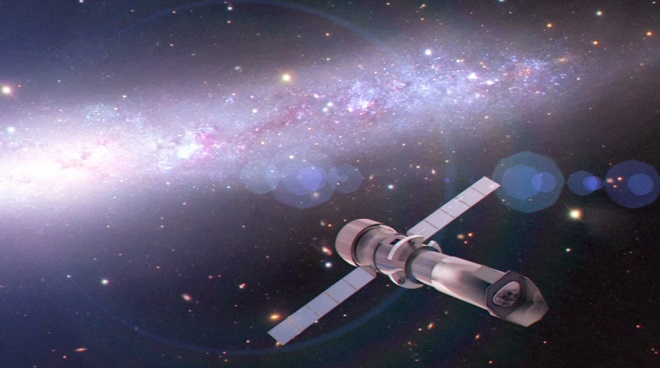Nov 29, 2013
At its meeting in Paris today, the Science Programme Committee of the European Space Agency (ESA) selected the "The Hot and Energetic Universe" as the science theme for its next Large (L-class) mission.
The mission is expected to be launched in 2028, with the power to address some of the most fundamental questions in modern astrophysics.
The science theme was proposed by an international collaboration led by Kirpal Nandra, Director at the Max Planck Institute for Extraterrestrial Physics (MPE) in Germany, with major inputs from the Universities of Leicester and Cambridge in the UK.
The same team is now well placed to lead the delivery of a major space observatory, with observing capabilities ideally matched to the L2 theme.
With the L2 selection ESA have ensured that astronomers worldwide will have access in the future to X-ray observations matching those becoming available at other wavelengths, in particular from NASA’S James Webb Telescope (successor to Hubble), and major new ground-based optical and radio telescopes such as ALMA and SKA.
ESA has already established a leading position in X-ray Astronomy, with the highly successful XMM-Newton Observatory about to begin its 15th year in orbit, having already yielded over 3500 scientific publications, reporting many discoveries and improved understanding on a wide range of astrophysical phenomena.
The enormous scope for the L2 mission, with an order of magnitude greater photon grasp and 100 times better spectral resolution than XMM, is underlined by the recently published 3XMM source catalogue containing over 375000 cosmic X-ray sources.
Professor Mike Watson from the University of Leicester, lead scientist on the XMM survey team, said: “Many of the fainter sources in 3XMM are likely to be at high redshift and very relevant to the L2 science objectives”.
Hot gas in the Universe is the dominant form of ordinary matter, the same material that everything we see around us is made from. The hot gas forms the largest structures in the visible Universe, aggregated around clusters of galaxies. With temperatures of more than a million degrees, the gas emits copiously at X-ray wavelengths.
With the new mission, astronomers will measure the properties of galaxy clusters in the distant Universe, and map the physical characteristics of the largest structures known - information dramatically advancing our understanding of how these structures first assembled when the Universe was just two billion years old.
Mapping the motion, temperature and chemical composition of the hot gas and tracking it through cosmic time are crucial to understanding the evolution of the galaxies and stars we see today.
With the powerful new X-ray Observatory, astronomers will be able to look still further back, to observe the first supermassive black holes, and to a time when the first galaxies were forming, less than one billion years after the Big Bang. Because of the extremely high temperatures and the huge energies deposited by matter as it falls into a black hole, X-ray emission is the most reliable and complete way of revealing such accreting monsters.
Professor Andy Fabian of the University of Cambridge said: “Processes originating close to the black hole are able to influence galaxies and galaxy clusters on scales up to a billion times larger– this `cosmic feedback’ is therefore an essential ingredient of galaxy evolution models.”
Tracking the growth of supermassive black holes through cosmic time, in the earliest epoch of galaxy formation (at z=6-10) is impossible with current instrumentation.
“We now have the X-ray optics technologies to provide the required leap in collecting area and angular resolution for wide field X-ray imaging,” says Professor Dick Willingale of the University of Leicester, “mapping the X-ray Universe with exquisite sensitivity over unparalleled sky areas and bringing the earliest supermassive black holes within our grasp.”
Following ESA’s acceptance of the science theme, the next step will be a call for an X-ray Observatory concept able to achieve the science goals. As the proposers of the theme and with the required technologies in hand, the Athena team are confident their mission will make the grade. Once a mission concept has been selected there is expected to be a period of 3-4 years to consolidate the technology development.
It will take another 10 years or so to build the Observatory. In 2028, Athena should begin to reveal the Hot and Energetic Universe in unprecedented detail, and provide an answer to that most basic question - why does the Universe look like it does today.
Plans for a mission like Athena started in an international research meeting held at the University of Leicester in July 1996 entitled "The Next Generation of X-ray Observatories". Since then Leicester astronomers and instrumentation scientists have been core members of an international effort working towards this ambitious goal.
The announcement by ESA that the "Hot and Energetic Universe" is to be the science theme for the next L-class mission concludes 18 years of planning and research and heralds the start of 14 years of technological research and development necessary to convert that original dream into reality.
Professor George Fraser, Director of the University’s Space Research Centre, said: “The X-ray images produced by the Athena telescope will place tremendous demands on the observatory’s Wide Field Imager, but experience already gained on existing missions gives us confidence in its design and successful development”.
More information on Athena can be found on the project webpages: http://athena2.irap.omp.eu/
“The Hot and Energetic Universe” White Paper can be downloaded here: http://athena2013.irap.omp.eu/WP/The_Hot_and_Energetic_Universe.pdf















